Photocatalytic Efficiency of Pure and Palladium Co-Catalytic Modified Binary System
Abstract
1. Introduction
2. Results and Discussion
2.1. X-Ray Diffraction and Thermal Stability of the Gels
2.2. SEM Morphology of the Synthesized Gels
2.3. Optical Properties of the Gels and Pd Modified Mixed Catalysts
2.4. Photocatalytic Properties of the Investigated Pure and Pd Modified Samples
3. Materials and Methods
3.1. Gels Preparation
3.2. Samples Characterization
3.3. Photocatalytic Testing
4. Conclusions
Author Contributions
Funding
Institutional Review Board Statement
Informed Consent Statement
Data Availability Statement
Acknowledgments
Conflicts of Interest
References
- Gomes, K.M.S.; de Oliveira, M.V.G.A.; de Sousa Carvalho, F.R.; Menezes, C.C.; Peron, A.P. Citotoxicity of food dyes sunset yellow (E-110), bordeaux red (E-123), and tatrazine yellow (E-102) on Allium cepa L. root meristematic cells. Food Sci. Technol. 2013, 33, 218–223. [Google Scholar] [CrossRef]
- Arnold, L.E.; Lofthouse, N.; Hurt, E. Artificial food colors and attention-deficit/hyperactivity symptoms: Conclusions to dye for. Neurotherapeutics 2012, 9, 599–609. [Google Scholar] [CrossRef] [PubMed]
- Martins, N.; Roriz, C.L.; Morales, P.; Barros, L.; Ferreira, I.C. Food colorants: Challenges, opportunities and current desires of agro-industries to ensure consumer expectations and regulatory practices. Trends Food Sci. Technol. 2016, 52, 1–15. [Google Scholar] [CrossRef]
- Amchova, P.; Kotolová, H.; Ruda-Kucerova, J. Health safety issues of synthetic food colorants. Regul. Toxicol. Pharmacol. 2015, 73, 914–922. [Google Scholar] [CrossRef] [PubMed]
- Navia-Mendoza, J.; Filho, O.; Zambrano-Intriago, L.; Maddela, N.; Duarte, M.; Quiroz-Fernández, L.; Baquerizo-Crespo, R.; Rodríguez-Díaz, J. Advances in the Application of Nanocatalysts in Photocatalytic Processes for the Treatment of Food Dyes: A Review. Sustainability 2021, 13, 11676. [Google Scholar] [CrossRef]
- Khan, K.; Shah, A.; Nisar, J.; Haleem, A.; Shah, I. Photocatalytic Degradation of Food and Juices Dyes via Photocatalytic Nanomaterials Synthesized through Green Synthetic Route: A Systematic Review. Molecules 2023, 28, 4600. [Google Scholar] [CrossRef]
- König, J. 2—Food colour additives of synthetic origin. In Colour Additives for Foods and Beverages, Woodhead Publishing Series in Food Science, Technology and Nutrition; Woodhead Publishing: Sawston, UK, 2015; pp. 35–60. [Google Scholar]
- Leek, T. Food additives and reactions: Antioxidants, benzoates, parabens, colorings, flavorings, natural protein-based additives. Encycl. Food Allergy 2024, 862–881. [Google Scholar] [CrossRef]
- Lockey, S. Allergic reactions due to F D and C Yellow No. 5, tartrazine, an aniline dye used as a coloring and identifying agent in various steroids. Ann. Allergy 1959, 17, 719–721. [Google Scholar]
- Stevenson, D.; Simon, R.; Lumry, W. Adverse reactions to tartrazine. J. Allergy Clin. Immunol. 1986, 78, 182–191. [Google Scholar] [CrossRef]
- Choulis, N. Chapter 49—Miscellaneous drugs, materials, medical devices, and techniques. Side Eff. Drugs Annu. 2011, 33, 1009–1029. [Google Scholar]
- Ramesh, M.; Muthuraman, A. Chapter 1—Flavoring and Coloring Agents: Health Risks and Potential Problems. In Natural and Artificial Flavoring Agents and Food Dyes; Handbook of Food Bioengineering; Academic Press: Cambridge, MA, USA, 2018; pp. 1–28. [Google Scholar]
- Katheresan, V.; Kansedo, J.; Lau, S.Y. Efficiency of various recent wastewater dye removal methods: A review. J. Environ. Chem. Eng. 2018, 6, 4676–4697. [Google Scholar] [CrossRef]
- Zare, K.; Gupta, V.K.; Moradi, O.; Makhlouf, A.S.H.; Sillanpää, M.; Nadagouda, M.N.; Sadegh, H.; Shahryari-Ghoshekandi, R.; Pal, A.; Wang, Z. A comparative study on the basis of adsorption capacity between CNTs and activated carbon as adsorbents for removal of noxious synthetic dyes: A review. J. Nanostruct. Chem. 2015, 5, 227–236. [Google Scholar] [CrossRef]
- Vuono, D.; Catizzone, E.; Aloise, A.; Policicchio, A.; Agostino, R.G.; Migliori, M.; Giordano, G. Modelling of adsorption of textile dyes over multi-walled carbon nanotubes: Equilibrium and kinetic. Chin. J. Chem. Eng. 2017, 25, 523–532. [Google Scholar] [CrossRef]
- Prashant, D.; Sarvalkar, P.; Kamble, S.; Powar, P.; Kakade, S.; Jamadar, A.; Thounaojam, P.; Patil, M.; Kalake, S.; Nimbalkar, M.; et al. Synthesized rGO/f-MWCNT-architectured 1-D ZnO nanocomposites for azo dyes adsorption, photocatalytic degradation, and biological applications. Catal. Commun. 2024, 187, 106846. [Google Scholar]
- Khaki, M.R.D.; Shafeeyan, M.S.; Raman, A.A.A.; Daud, W.M.A.W. Application of doped photocatalysts for organic pollutant degradation—A review. J. Environ. Manag. 2017, 198, 78–94. [Google Scholar] [CrossRef]
- Samarasinghe, L.; Muthukumaran, S.; Baskaran, K. Recent advances in visible light-activated photocatalysts for degradation of dyes: A comprehensive review. Chemosphere 2024, 349, 140818. [Google Scholar] [CrossRef]
- Shen, J.; Chuang, H.; Horng, J. Enhanced photocatalytic mechanism of hydroxyl radical formation in the composite reaction of TiO2/oxidant for azo dye degradation. Desalin. Water Treat. 2017, 96, 153–160. [Google Scholar] [CrossRef]
- Konstantinou, I.K.; Albanis, T.A. TiO2-assisted photocatalytic degradation of azo dyes in aqueous solution: Kinetic and mechanistic investigations: A review. Appl. Catal. B Environ. 2004, 49, 1–14. [Google Scholar] [CrossRef]
- Reza, K.M.; Kurny, A.; Gulshan, F. Parameters affecting the photocatalytic degradation of dyes using TiO2: A review. Appl. Water Sci. 2017, 7, 1569–1578. [Google Scholar] [CrossRef]
- Lee, K.M.; Lai, C.W.; Ngai, K.S.; Juan, J.C. Recent developments of zinc oxide based photocatalyst in water treatment technology: A review. Water Res. 2016, 88, 428–448. [Google Scholar] [CrossRef]
- Daneshvar, N.; Salari, D.; Khataee, A.; Khataee, A. Photocatalytic degradation of azo dye acid red 14 in water on ZnO as an alternative catalyst to TiO2. J. Photochem. Photobiol. A Chem. 2004, 162, 317–322. [Google Scholar] [CrossRef]
- Kansal, S.; Singh, M.; Sud, D. Studies on photodegradation of two commercial dyes in aqueous phase using different photocatalysts. J. Hazard. Mater. 2007, 141, 581–590. [Google Scholar] [CrossRef]
- Dahl, M.; Liu, Y.; Yin, Y. Composite Titanium Dioxide Nanomaterials. Chem. Rev. 2014, 114, 9853–9889. [Google Scholar] [CrossRef] [PubMed]
- Carp, O.; Huisman, C.; Reller, A. Photoinduced Reactivity of Titanium Dioxide. Prog. Solid State Chem. 2004, 32, 33–177. [Google Scholar] [CrossRef]
- Bachvarova-Nedelcheva, A.; Gegova, R.; Stoyanova, A.; Iordanova, R.; Copcia, V.; Ivanova, N.; Sandu, I. Synthesis, characterization and properties of ZnO/TiO2 powders obtained by combustion gel method. Bulg. Chem.Commun. 2014, 46, 585–593. [Google Scholar]
- Shalaby, A.; Bachvarova-Nedelcheva, A.; Iordanova, R.; Dimitriev, Y.; Stoyanova, A.; Hitkova, H.; Ivanova, N.; Sredkova, M. Sol-gel synthesis and properties of nanocomposites in the Ag/TiO2/ZnO system. J. Optoelectron. Adv. Mater. 2015, 17, 248–256. [Google Scholar]
- Najjar, R.; Shokri, M.; Farsadi, S. Preparation of Pd-doped nano-TiO2 in microemulsion and their application in photodegradation of C.I. Acid Yellow 23. Desalination Water Treat. 2015, 54, 2581–2591. [Google Scholar] [CrossRef]
- Banerjee, A.N.; Nazanin, H.; Joo, S.W. A comparative study of the effect of Pd-doping on the structural, optical, and photocatalytic properties of sol-gel derived anatase TiO2 nanoparticles. Ceram. Int. 2016, 42, 12010–12023. [Google Scholar] [CrossRef]
- Sakthivel, S.; Shankar, M.V.; Palanichamy, M.; Arabindoo, B.; Bahnemann, D.W.; Murugesan, V. Enhancement of photocatalytic activity by metal deposition: Characterisation and photonic efficiency of Pt, Au and Pd deposited on TiO2 catalyst. Water Res. 2004, 38, 3001–3008. [Google Scholar] [CrossRef]
- Babu, N.S.; Lingaiah, N.; Pasha, N.; Kumar, J.V.; Prasad, P.S.S. Influence of particle size and nature of Pd species on the hydrodechlorination of chloroaromatics: Studies on Pd/TiO2 catalysts in chlorobenzene conversion. Catal. Today 2009, 141, 120–124. [Google Scholar] [CrossRef]
- Chan, C.-C.; Chang, C.-C.; Hsu, W.-C.; Wang, S.; Lin, J. Photocatalytic activities of Pd-loaded mesoporous TiO2 thin films. Chem. Eng. J. 2009, 152, 492–497. [Google Scholar] [CrossRef]
- Abdelaal, M.Y.; Mohamed, R.M. Novel Pd/TiO2 nanocomposite prepared by modified sol–gel method for photocatalytic degradation of methylene blue dye under visible light irradiation. J. Alloys Compd. 2013, 576, 201–207. [Google Scholar] [CrossRef]
- Espino-Estévez, M.R.; Fernández-Rodríguez, C.; González-Díaz, O.M.; Araña, J.; Espinós, J.P.; Ortega-Méndez, J.A.; Doña-Rodríguez, J.M. Effect of TiO2–Pd and TiO2–Ag on the photocatalytic oxidation of diclofenac, isoproturon and phenol. Chem. Eng. J. 2016, 298, 82–95. [Google Scholar] [CrossRef]
- Bachvarova-Nedelcheva, A.; Iordanova, R.; Kaneva, N. The Solvent Role for the Decomposition of Paracetamol in Distilled and Drinking Water by Pure and Ag-Modified TiO2 Sol–Gel Powders. Materials 2024, 17, 1791. [Google Scholar] [CrossRef]
- Kaneva, N.; Bachvarova-Nedelcheva, A. The Effect of Heat Treatment on the Sol–Gel Preparation of TiO2/ZnO Catalysts and Their Testing in the Photodegradation of Tartrazine. Appl. Sci. 2024, 14, 9872. [Google Scholar] [CrossRef]
- Kwak, B.S.; Chae, J.; Kim, J.; Kang, M. Enhanced Hydrogen Production from Methanol/Water Photo-Splitting in TiO2 Including Pd Component. Bull. Korean Chem. Soc. 2009, 30, 1047. [Google Scholar]
- Yan, J.; Li, X.; Jin, B.; Zeng, M.; Peng, R. Synthesis of TiO2/Pd and TiO2/PdO Hollow Spheres and Their Visible Light Photocatalytic Activity. Int. J. Photoenergy 2020, 2020, 4539472. [Google Scholar] [CrossRef]
- Yordanov, S.I.; Bachvarova-Nedelcheva, A.D.; Iordanova, R.S.; Stambolova, I.D. Sol-gel synthesis and properties of Sm modified TiO2 nanopowders. Bulg. Chem. Commun. 2018, 50, 42–48. [Google Scholar]
- Wang, L.; Fu, X.; Han, Y.; Chang, E.; Wu, H.; Wang, H.; Li, K.; Qi, X. Preparation, Characterization, and Photocatalytic Activity of TiO2/ZnO Nanocomposites. J. Nanomater. 2013, 2013, 321459. [Google Scholar] [CrossRef]
- Bachvarova-Nedelcheva, A.; Iordanova, R.; Kostov, K.L.; Gegova, R. Sol-gel powder synthesis in the TiO2-TeO2-ZnO system: Structural characterization and properties. Arab. J. Chem. 2020, 13, 7132–7146. [Google Scholar] [CrossRef]
- Siwińska-Stefańska, K.; Kubiaka, A.; Piasecki, A.; Goscianska, J.; Nowaczyk, G.; Jurga, S.; Jesionowski, T. TiO2-ZnO Binary Oxide Systems: Comprehensive Characterization and Tests of Photocatalytic Activity. Materials 2018, 11, 841. [Google Scholar] [CrossRef] [PubMed]
- Irine, T.M.; Rathika, A. Improved Photocatalytic Activity of Pd-doped ZnO Nanoparticles Synthesized by Combustion Method. Int. J. Appl. Environ. Sci. 2022, 17, 43–60. [Google Scholar]
- Oliveira, A.F.; Silva, S.A.M.; Rubinger, C.P.; Ider, J.; Rubinger, R.M.; Oliveira, E.T.M.; Doriguetto, A.C.; de Carvalho, H.B. Preparation and characterization of palladium-doped titanium dioxide for solar cell applications. Mater. Sci. Eng. B 2022, 280, 115702. [Google Scholar] [CrossRef]
- Bai, N.; Liu, X.; Li, Z.; Ke, X.; Zhang, K.; Wu, Q. High-efficiency TiO2/ZnO nanocomposites photocatalysts by sol–gel and hydrothermal methods. J. Sol-Gel Sci. Technol. 2021, 99, 92–100. [Google Scholar] [CrossRef]
- Aramendía, M.A.; Borau, V.; Colmenares, J.; Marinas, A.; Marinas, J.; Navío, J.; Urbano, F. Modification of the photocatalytic activity of Pd/TiO2 and Zn/TiO2 systems through different oxidative and reductive calcination treatments. Appl. Catal. Environ. 2008, 80, 88–97. [Google Scholar] [CrossRef]
- Güy, N.; Çakar, S.; Özacar, M. Comparison of palladium/zinc oxide photocatalysts prepared by different palladium doping methods for congo red degradation. J. Colloid Int. Sci. 2016, 466, 128–137. [Google Scholar] [CrossRef]
- Turktena, N.; Bekbolet, M. Photocatalytic performance of titanium dioxide and zinc oxide binary system on degradation of humic matter. J. Photochem. Photobiol. A 2020, 401, 112748. [Google Scholar] [CrossRef]
- Zhao, J.; Dang, Z.; Muddassir, M.; Raza, S.; Zhong, A.; Wang, X.; Jin, J. A New Cd(II)-Based Coordination Polymer for Efficient Photocatalytic Removal of Organic Dyes. Molecules 2023, 28, 6848. [Google Scholar] [CrossRef]
- Zheng, Y.; Chen, C.; Zhan, Y.; Lin, X.; Zheng, Q.; Wei, K.; Zhu, J. Photocatalytic Activity of Ag/ZnO Heterostructure Nanocatalyst: Correlation between Structure and Property. J. Phys. Chem. C 2008, 112, 10773–10777. [Google Scholar] [CrossRef]
- Bera, A.; Basak, D. Pd-nanoparticle-decorated ZnO nanowires: Ultraviolet photosensitivity and photoluminescence proper-ties. Nanotechnology 2011, 22, 265501. [Google Scholar] [CrossRef]
- Li, S.; Cai, J.; Wu, X.; Zheng, F. Sandwich-like TiO2@ZnO-based noble metal (Ag, Au, Pt, or Pd) for better photo-oxidation performance: Synergistic effect between noble metal and metal oxide phases. Appl. Surf. Sci. 2018, 443, 603–612. [Google Scholar] [CrossRef]
- Suzuki, Y.; Yoshikawa, S. Synthesis and thermal analyses of TiO2-derived nanotubes prepared by the hydrothermal method. J. Mater. Res. 2004, 19, 982–985. [Google Scholar] [CrossRef]
- Siwińska-Stefańska, K.; Zdarta, J.; Paukszta, D.; Jesionowski, T. The influence of addition of a catalyst and chelating agent on the properties of titanium dioxide synthesized via the sol-gel method. J. Sol-Gel Sci. Technol. 2015, 75, 264–278. [Google Scholar] [CrossRef]
- Lawrence, M.; Dejene, F. Influence of annealing temperature on structural, optical and photocatalytic properties of ZnO–TiO2 composites for application in dye removal in water. Nano-Struct. Nano-Objects 2020, 24, 100594. [Google Scholar]
- Umar, A.; Kumar, R.; Kumar, G.; Algarni, H.; Kim, S. Effect of annealing temperature on the properties and photocatalytic efficiencies of ZnO nanoparticles. J. Alloys Compd. 2015, 648, 46–52. [Google Scholar] [CrossRef]
- Livage, C.; Safari, A.; Klein, L. Glycol-based sol-gel process for the fabrication of ferroelectric PZT thin films: Code: EP28. J. Sol-Gel Sci. Technol. 1994, 2, 605. [Google Scholar] [CrossRef]

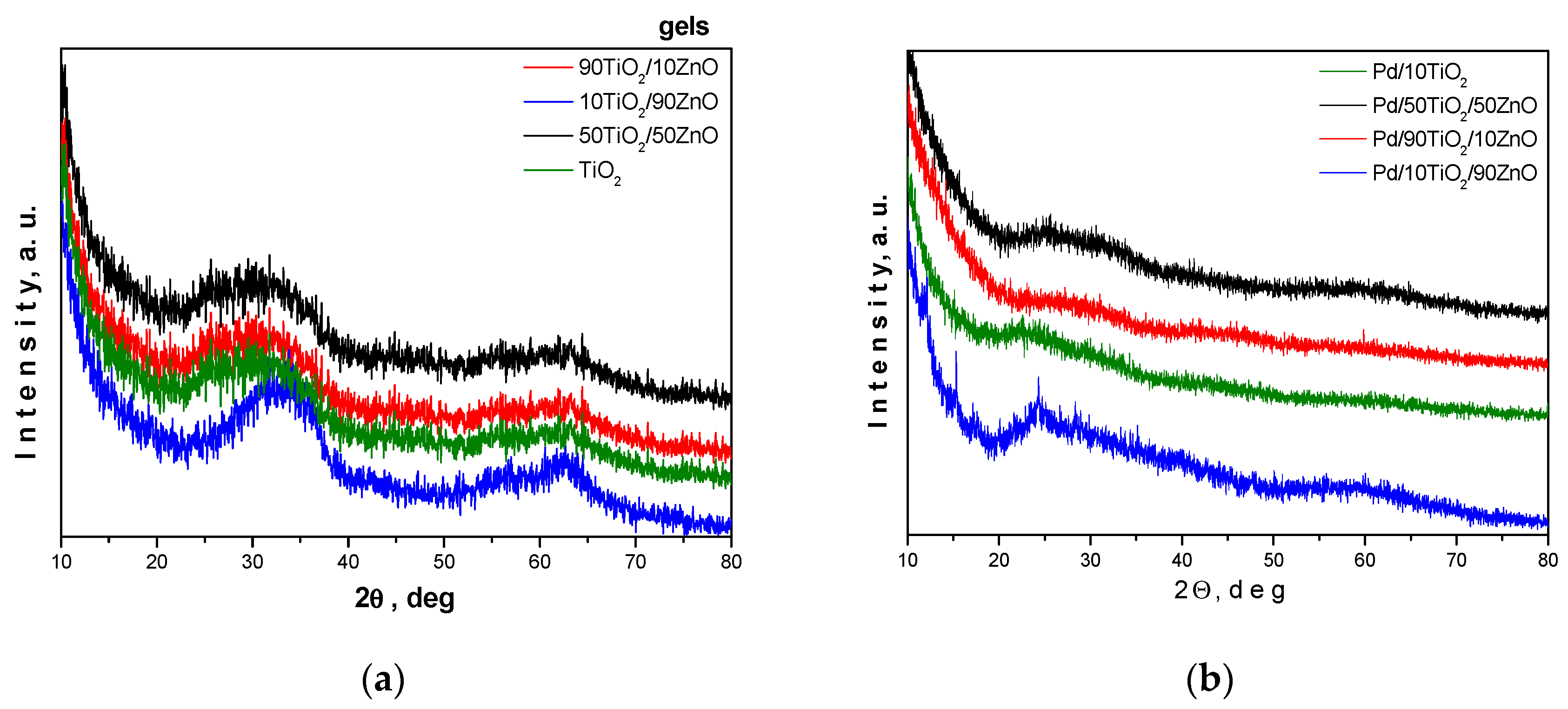
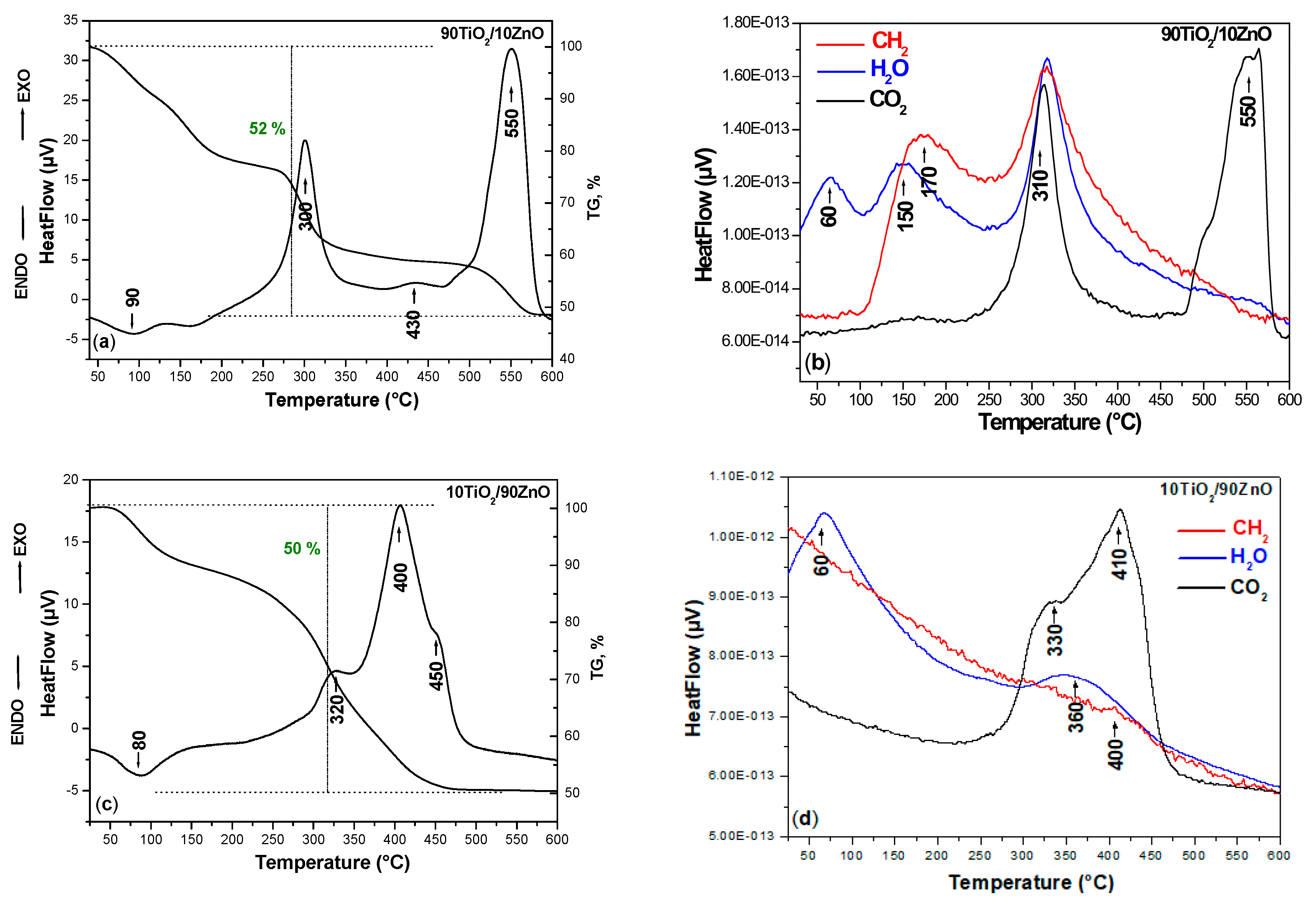
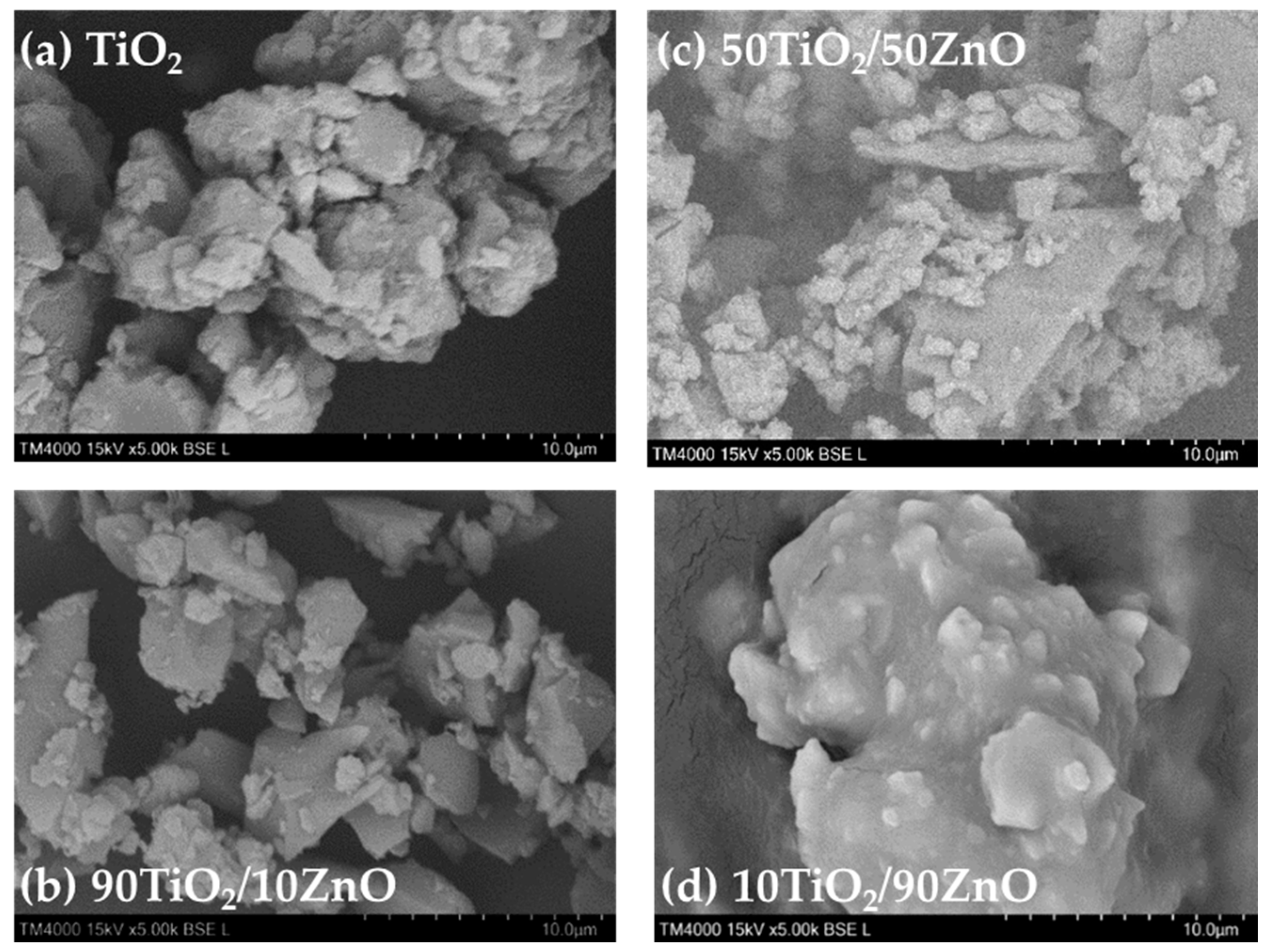


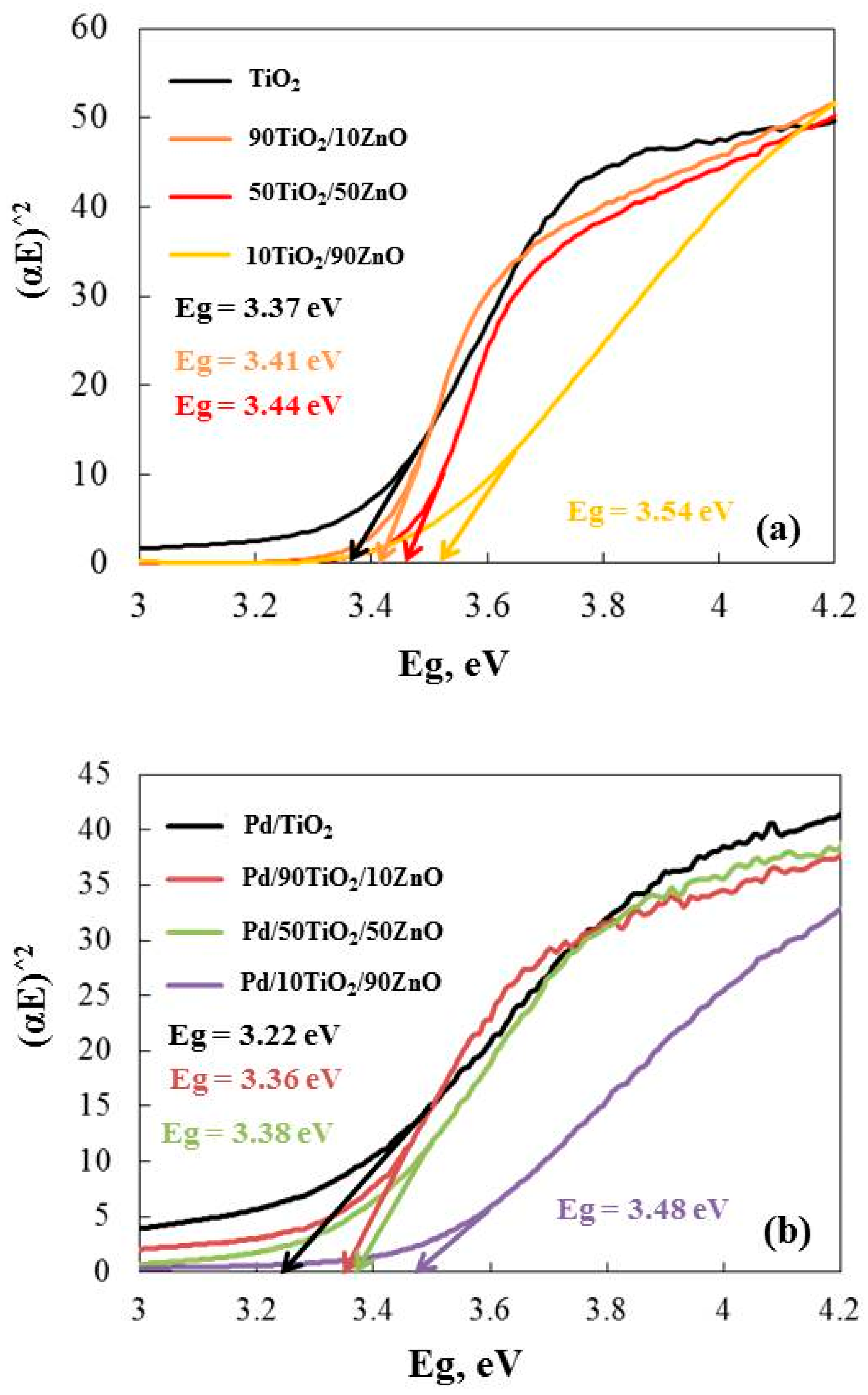
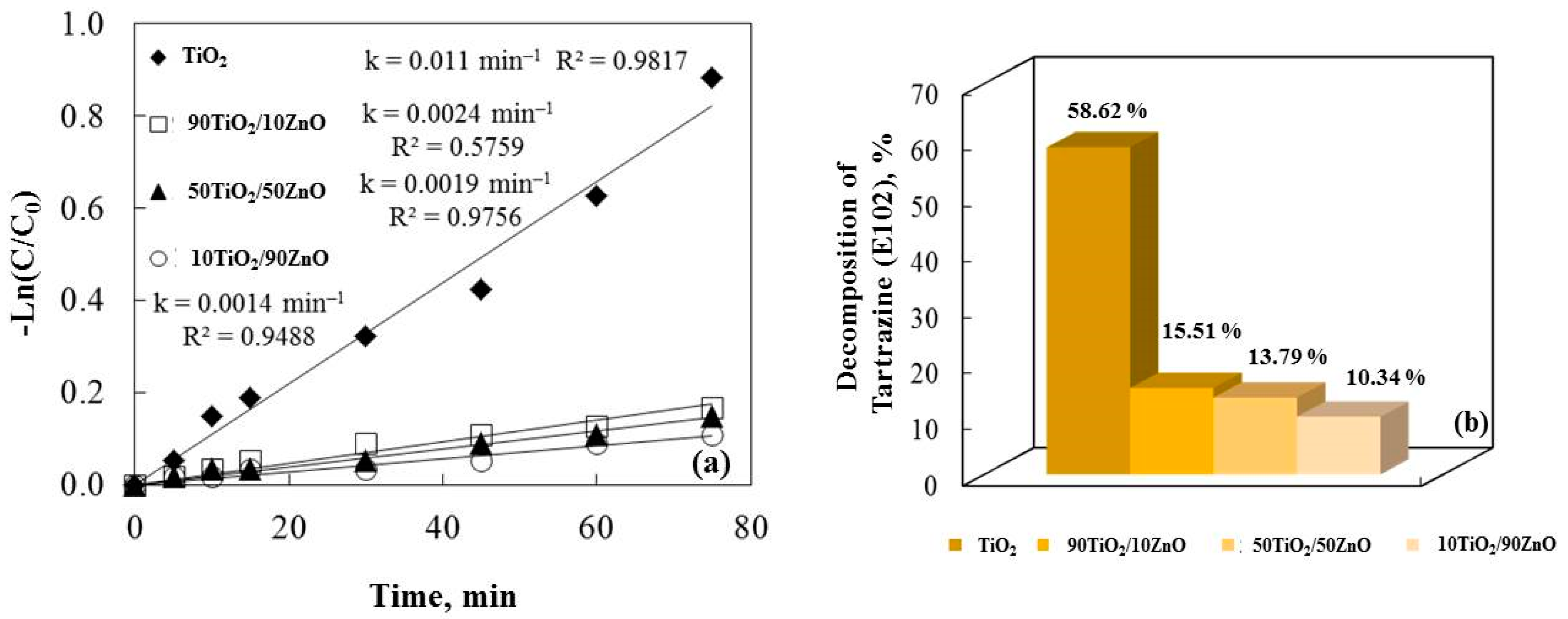


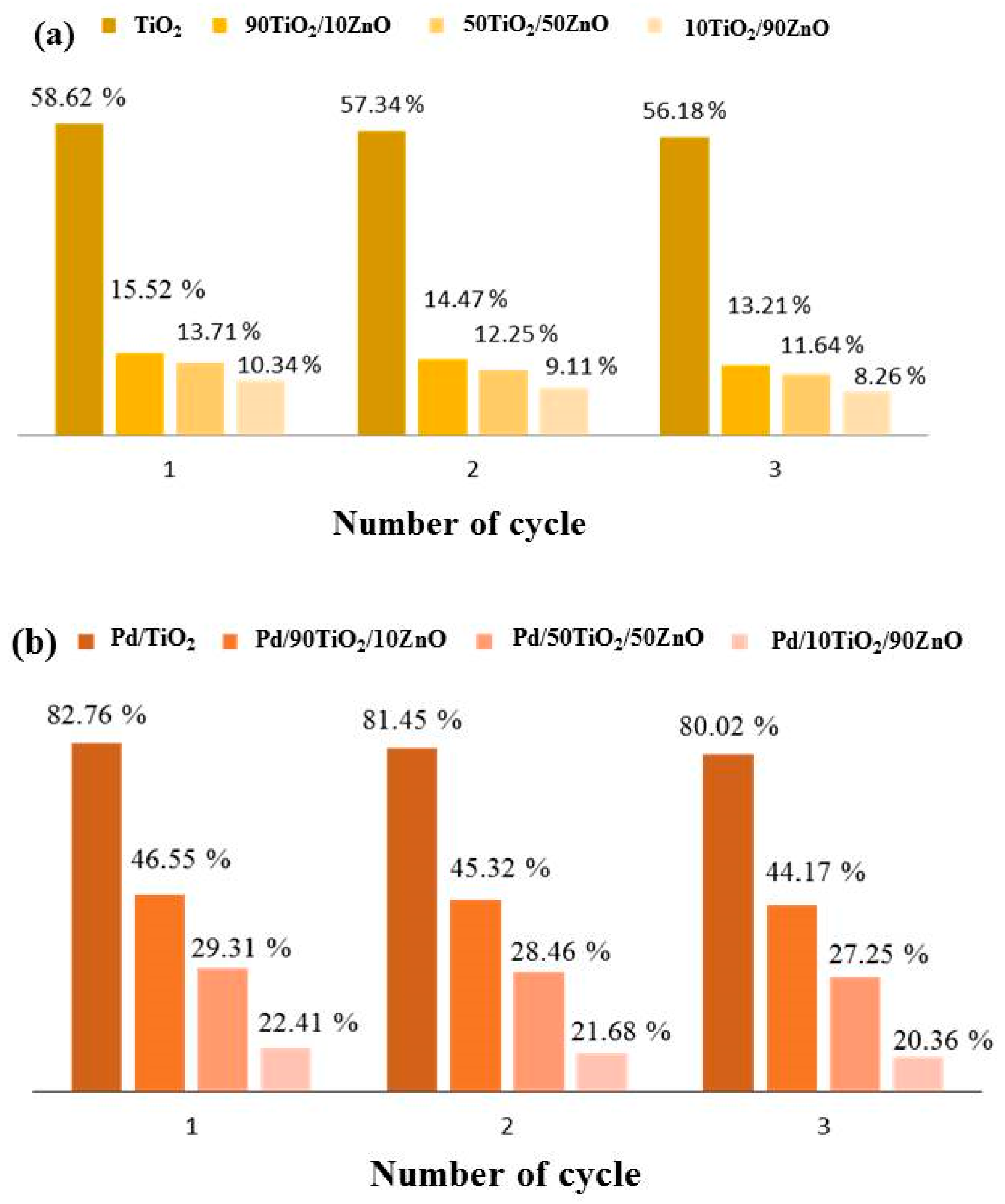
| Sample | Element | Pure Gels | Pd Doped Samples | ||
|---|---|---|---|---|---|
| Weight, % | Atomic, % | Weight, % | Atomic, % | ||
| TiO2 | O | 58.60 | 42.38 | 59.4 | 81.42 |
| Ti | 41.40 | 57.62 | 40.57 | 18.37 | |
| Pd | - | - | 0.04 | 0.01 | |
| - | - | - | 100 | - | 100 |
| 90TiO2/10ZnO | O | 53.27 | 77.64 | 58.46 | 81.37 |
| Ti | 43.70 | 21.27 | 36.13 | 16.79 | |
| Zn | 3.03 | 1.08 | 5.38 | 1.83 | |
| Pd | - | - | 0.04 | 0.01 | |
| - | - | - | 100 | - | 100 |
| 10TiO2/90ZnO | O | 33.81 | 67.52 | 67.18 | 88.82 |
| Ti | 0.70 | 0.47 | 4.82 | 2.13 | |
| Zn | 65.49 | 32.01 | 27.93 | 9.04 | |
| Pd | - | - | 0.08 | 0.01 | |
| - | - | - | 100 | 100 | |
| 50TiO2/50ZnO | O | 41.54 | 70.55 | 54.43 | 80.84 |
| Ti | 35.23 | 19.83 | 19.68 | 9.76 | |
| Zn | 23.23 | 9.50 | 25.82 | 9.39 | |
| Pd | - | - | 0.08 | 0.02 | |
| - | - | - | 100 | - | 100 |
Disclaimer/Publisher’s Note: The statements, opinions and data contained in all publications are solely those of the individual author(s) and contributor(s) and not of MDPI and/or the editor(s). MDPI and/or the editor(s) disclaim responsibility for any injury to people or property resulting from any ideas, methods, instructions or products referred to in the content. |
© 2025 by the authors. Licensee MDPI, Basel, Switzerland. This article is an open access article distributed under the terms and conditions of the Creative Commons Attribution (CC BY) license (https://creativecommons.org/licenses/by/4.0/).
Share and Cite
Kaneva, N.; Bachvarova-Nedelcheva, A. Photocatalytic Efficiency of Pure and Palladium Co-Catalytic Modified Binary System. Inorganics 2025, 13, 161. https://doi.org/10.3390/inorganics13050161
Kaneva N, Bachvarova-Nedelcheva A. Photocatalytic Efficiency of Pure and Palladium Co-Catalytic Modified Binary System. Inorganics. 2025; 13(5):161. https://doi.org/10.3390/inorganics13050161
Chicago/Turabian StyleKaneva, Nina, and Albena Bachvarova-Nedelcheva. 2025. "Photocatalytic Efficiency of Pure and Palladium Co-Catalytic Modified Binary System" Inorganics 13, no. 5: 161. https://doi.org/10.3390/inorganics13050161
APA StyleKaneva, N., & Bachvarova-Nedelcheva, A. (2025). Photocatalytic Efficiency of Pure and Palladium Co-Catalytic Modified Binary System. Inorganics, 13(5), 161. https://doi.org/10.3390/inorganics13050161








